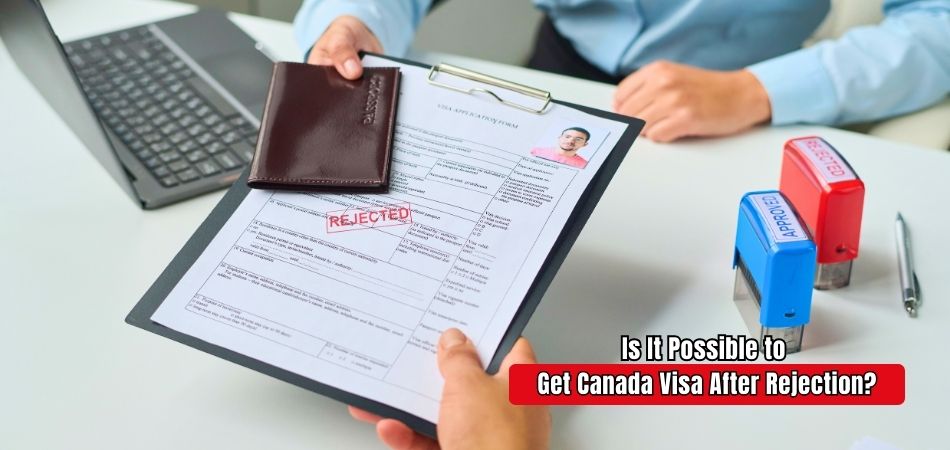Facing a visa rejection can be a terrifying experience for many interested travelers and students. The disappointment can overshadow the excitement of potential new opportunities in Canada. After such a setback, individuals often wonder, “Is it possible to get Canada visa after rejection?” This question remains in the minds of many, leading them to seek clarity on the path forward.
Yes, it is indeed possible to obtain a Canadian visa after experiencing a rejection. Many applicants successfully reapply by dealing with the issues that led to their initial denial. Key steps include identifying the rejection reasons, strengthening supporting documents, and presenting a more compelling case in the new application. With careful preparation, hopeful applicants can significantly increase their chances of success in their next attempt.
Are you curious about the details surrounding this topic? This article will provide you with all the necessary information on how to deal with the process of reapplying for a Canadian visa after rejection. By reading further, you will discover practical tips and insights that can help you achieve your travel or study goals in Canada.
What is the Probability of a Canadian Visa Being Rejected?
The probability of a Canadian visa being rejected varies depending on several factors. These include the type of visa being applied for and the applicant’s specific circumstances. For instance, tourist visa rejections may differ in frequency compared to student or work visa rejections.
For a more specific example, student visas generally have a higher acceptance rate than work visas, reflecting different evaluation criteria. Visa approval rates also fluctuate year by year, affected by changes in immigration policy or international relations.
While applicants often worry about the likelihood of rejection, most are successful in their applications if they meet all the criteria. For those concerned about typical reasons for Canada visa rejection, follow all the guidelines and provide complete, accurate documentation to increase the chance of approval. This step alone significantly enhances the chances of a favorable outcome, demonstrating the complexity of visa applications.
Is It Possible to Get Canada Visa After Rejection?
Although being denied a visa can be frustrating, it does not mean that your desire to travel to Canada is over. With careful preparation and addressing the issues from the previous application, it’s possible to reapply successfully. Here’s how you can do it.

Acknowledge the Reasons for Rejection
Carefully reviewing the rejection letter will help you identify the specific reasons for denial. This step is crucial in determining what went wrong. Common reasons might include missing documents or insufficient financial proof. Knowing these exact reasons is essential for addressing the issues effectively in your next application.
Identify Missing or Incorrect Documents
A rejection often occurs due to incomplete or incorrect documentation submitted with the application. Take time to gather the correct papers that were missing or found lacking. Make sure to check that all required documents are present and properly filled out, as this will improve your chances of approval when reapplying.
Strengthen Financial Proof
One common cause of visa rejection is insufficient proof of financial stability. If your previous application lacked strong evidence showing your ability to support yourself, address this issue thoroughly. Provide updated financial documents, such as bank statements and proof of income, that clearly demonstrate you can afford the expenses of your trip to Canada.
Improve Your Travel History
Sometimes, a weak travel history leads to visa rejection. If possible, consider traveling to other countries before reapplying for a Canadian visa. A stronger travel history shows you are more likely to return to your home country after your visit, which can reassure immigration officials about your intentions.
Show Stronger Ties to Home Country
To convince immigration officers that you will return home, provide stronger proof of ties to your home country. This evidence could include documentation of employment, property ownership, or family commitments.
Demonstrating that you have valid reasons to return home after visiting Canada is essential for a successful application.
Seek Legal or Professional Advice
If you’re unsure about how to fix the issues that led to rejection, consider consulting an immigration lawyer or consultant. These professionals can help you analyze your rejection better. They can also provide expert advice on how to improve your next application for a better chance of approval.
Ensure Accuracy in Personal Details
Errors in your personal information, such as your name or address, can lead to unnecessary complications during the visa application process. Double-check every section of your application to ensure there are no mistakes. Maintaining accuracy in your application is essential to avoid any issues that might arise during processing.
Reapply After Making Necessary Corrections
Once all issues from your previous application are resolved, you can confidently reapply. Address all the previous rejection points and submit a stronger application. Ensure that every aspect of your application is clear, complete, and supported by the right documents to improve your chances of success.
Securing a Canadian visa after rejection is achievable if you address previous mistakes and submit a well-prepared application. Careful attention to detail and resolving any concerns will significantly increase your chances of a successful outcome.
How to Correct Mistakes That Led to Your Visa Rejection?
It takes careful effort and close attention to detail to fix errors that result in a visa rejection. Making sure you handle each issue thoroughly can greatly increase your chances of success when reapplying. Below are several important steps to guide you.
Review the Application in Detail
Go through the original visa application carefully to spot any mistakes or oversights. Pay attention to even the smallest detail, as small errors can affect the outcome. This step is key to identifying all the potential areas of improvement for your next submission.
Ensure Documents Are Accurate
Check that all submitted documents match the required criteria, including dates, signatures, and other relevant details. Inaccuracies in documents can lead to confusion during processing. Making sure everything is in order will help avoid unnecessary delays or issues with your next application.
Strengthen Personal Details
Weaknesses in personal details, such as incomplete background information, can hurt your chances. Strengthening your personal data means ensuring that all the information provided, including employment and travel history, is comprehensive and verifiable. This adds credibility to your application.
Double-Check Financial Information
Errors in financial documentation can be a significant problem for visa approval. Make sure your bank statements, tax documents, and other financial proof are up-to-date and accurately reflect your current situation. This will help demonstrate that you meet financial stability requirements.
Seek Advice from Professionals
Consulting with an immigration expert can help you gain more clarity on how to correct mistakes. These professionals have experience with visa applications and can offer specific advice on addressing errors. Their insight could make a difference in achieving a successful result.
Correcting mistakes is a crucial part of improving your chances for future visa approval. By thoroughly reviewing your application and making the necessary adjustments, you can create a much stronger application and increase the possibility of success.
What is the Waiting Period Before Reapplying for a Canada Visa?
After being rejected, reapplying for a Canada visa can be difficult. Knowing the waiting period is essential for planning your next steps effectively. Here’s what you need to know about the timeline before reapplying.
General Waiting Period Guidelines
Typically, there is no mandatory waiting period before reapplying for a Canada visa after rejection. However, it is advisable to take some time to address the reasons for denial. This waiting period allows you to prepare a stronger application that addresses any concerns from your previous submission.
Analyze the Reasons for Denial
Taking time to review the rejection reasons is crucial before reapplying. Avoid repeating the same mistakes by understanding what caused the denial. Carefully considering each issue will improve your chances of a successful application in the future and provide clarity on how to strengthen your case.
Time Needed for Documentation
Gathering the necessary documentation can take time. You may need to collect updated financial records, proof of ties to your home country, or additional information. This process may require several weeks, depending on the specific documents you need to gather to support your new application.
Seeking Professional Help
If you choose to consult with an immigration lawyer or consultant, factor in the time required for their assistance. Professionals can help review your application and provide advice on improving your chances. This guidance may take time, but it is valuable for enhancing the quality of your next application.
Monitoring Changes in Immigration Policies
Staying informed about any changes in Canadian immigration policies is essential. New rules or requirements can affect your application process and may require additional time to adapt. Regularly checking official sources ensures your reapplication meets the latest criteria, helping you submit a stronger application.
To ensure a successful outcome, be aware of the waiting period before reapplying for a Canada visa. Taking time to prepare thoroughly will increase your chances of approval in future applications, so be sure to plan accordingly.
How to Reapply for a Canada Student Visa After Rejection?
It can be difficult to reapply for a Canadian student visa after being denied one, but it is not impossible. Taking the proper steps, addressing past issues, and refining your approach can significantly increase your chances of success the second time around.
Analyze Your Rejection Notice
The first step after a visa rejection is to thoroughly review your rejection notice. This document will give you specific details on what led to the denial. By knowing these issues, you can better prepare your next application to avoid the same mistakes and ensure a smoother process.
Strengthen Your Study Plan
A detailed and convincing study plan is critical when reapplying for a student visa. Your study plan should clearly outline why you chose Canada for your studies and how your program aligns with your career goals. A well-written plan can demonstrate commitment and focus, increasing your chances of approval.
Improve Your Supporting Documents
Reapplying with stronger supporting documents is crucial to overcoming a previous rejection. This involves ensuring that financial proof, academic credentials, and any other required documents are complete and accurate. Providing robust documentation plays a significant role in determining the number of times reapply for Canada visa after rejection, as it helps prevent repetitive mistakes that could result in multiple denials.
Provide Proof of Ties to Your Home Country
When reapplying, strengthen your proof of ties to your home country. Showing that you have strong reasons to return home after completing your studies, such as family commitments, job offers, or property, will reassure visa officers of your intentions.
Consider Seeking Professional Advice
If you feel uncertain about your application or have doubts about how to improve it, consulting an immigration consultant or lawyer may help. These professionals can provide valuable insights into the application process and help you address any weak areas in your previous submission, ensuring a higher chance of success.
Reapplying for a Canadian student visa requires careful attention to detail and addressing any issues from the first application. By taking the time to improve your documents and strengthen your case, you increase your likelihood of securing a visa in future attempts.
FAQs About Is It Possible to Get Canada Visa After Rejection?
Facing a Canadian visa rejection can raise many questions. Below, we’ve compiled answers to some common concerns that arise after a visa denial. These FAQs will help clarify your doubts and guide you in the reapplication process.
Can You Appeal a Canada Visa Rejection?
Yes, you can appeal a Canadian visa rejection, but the process depends on the visa type. For temporary visas like tourist or study visas, there is typically no formal appeal process. Instead, applicants can submit a new application that addresses the specific reasons for the initial rejection to improve their chances.
How Long Should You Wait Before Reapplying?
There is no mandatory waiting period before reapplying for a Canada visa after a rejection. However, it is wise to take the time needed to fully address the reasons for the denial. Rushing to reapply without correcting mistakes may lead to another rejection, so careful preparation is essential.
Do You Need New Documents When Reapplying?
Yes, when reapplying for a Canada visa, provide new or updated documents. This includes correcting any inaccuracies from the previous application and supplying additional evidence if necessary. Ensuring all required documents are complete and accurate helps demonstrate your commitment and significantly improves your chances of approval.
Will a Previous Rejection Affect Your Future Applications?
While a previous rejection does not automatically disqualify you from future applications, address the issues that led to the denial. Each application is considered on its own merits, so presenting a well-prepared and strengthened case will improve your likelihood of securing a visa in subsequent attempts.
Can You Use the Same Application After a Rejection?
Using the same application after a rejection is not advisable. Instead, you should thoroughly review and revise your application. Correct any errors, update any outdated information, and include any additional documents needed. This approach helps present a stronger case, increasing the chances of a successful outcome on your next application.
Last Words
If you follow the correct procedures, it is definitely possible to reapply for a Canadian visa after being rejected. By addressing the issues from your previous application and submitting stronger documents, your chances of approval improve significantly. So, to answer the question, “Is it possible to get Canada visa after rejection?” Yes, it is!
As you prepare for your next application, focus on providing clear and accurate information, strengthen your supporting documents, and ensure you meet all the requirements. Best of luck with your reapplication, and may your efforts lead to a successful outcome!







